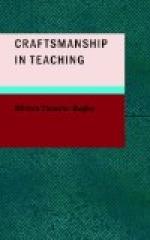IV
But I did not propose this morning to talk to you about science as a part of our educational curriculum, but rather about the scientific spirit and the scientific method as effective instruments for the solution of our own peculiar educational problems. I have tried to give you reasons for believing that an adoption of this policy does not necessarily commit us to materialism or to a narrowly economic point of view. I have attempted to show that the scientific method may be applied to the solution of our problems while we still retain our faith in ideals; and that, unless we do retain that faith, our investigations will be without point or meaning.
This problem of vocational education to which I have just referred is one that is likely to remain unsolved until we have made a searching investigation of its factors in the light of scientific method. Some people profess not to be worried by the difficulty of finding time in our elementary and secondary schools for the introduction of the newer subjects making for increased vocational efficiency. They would cut the Gordian knot with one single operation by eliminating enough of the older subjects to make room for the new. I confess that this solution does not appeal to me. Fundamentally the core of the elementary curriculum must, I believe, always be the arts that are essential to every one who lives the social life. In other words, the language arts and the number arts are, and always must be, the fundamentals of elementary education. I do not believe that specialized vocational education should ever be introduced at the expense of thorough training in the subjects that already hold their place in the curriculum. And yet we are confronted by the economic necessity of solving in some way this vocational problem. How are we to do it?
It is here that the scientific method may perhaps come to our aid. The obvious avenue of attack upon this problem is to determine whether we cannot save time and energy, not by the drastic operation of eliminating old subjects, but rather by improving our technique of teaching, so that the waste may be reduced, and the time thus saved given to these new subjects that are so vociferously demanding admission. In Cleveland, for example, the method of teaching spelling has been subjected to a rigid scientific treatment, and, as a result, spelling is being taught to-day vastly better than ever before and with a much smaller expenditure of time and energy. It has been due, very largely, to the application of a few well-known principles which the science of psychology has furnished.
Now that is vastly better than saying that spelling is a subject that takes too much time in our schools and consequently ought forthwith to be eliminated. In all of our school work enough time is undoubtedly wasted to provide ample opportunity for training the child thoroughly in some vocation if we wish to vocationalize him, and I do not think that this would hurt him, even if he does not follow the vocation in later life.




